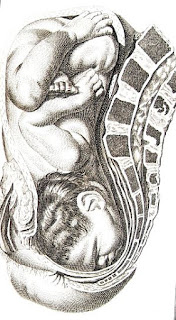Some of us like to face the music, face the facts, turn to the light, face life full on…
The baby who is coming face first, or face presentation, most often is born fine in this position.
There may be a little slow down after ten centimeters which can be helped by standing in a shower, moving and swaying, each a variation for comfort while standing through contractions.
 |
| From book of Smellie, 1800s |
Face presentation is not the same as posterior presentation. But a face presentation can be occiput posterior with the chin anterior.
You may see more face presentations among premature babies, large babies, babies without skull development (anencephaly) or in women with small pelvis and large baby. Abundant amniotic fluid may allow for a face presentation, and those are the medical list. I would add that a twist in the lower uterine segment such as may also make a posterior or even a breech baby more likely may alternatively lead to face presentation. A fall or jolt during or long before pregnancy may be examples of events that can cause such a twist.
Face presentations occur from about 1/500–to 1/1,250 term births depending on who you ask. Duff and Benedetti wrote about face presentations in the 1980s.
The chin is the landmark of the face presentation, unlike a flexed baby whose occiput is the landmark.
- Left Mento-Anterior (LMA), Left Mento-Posterior (LMP), Left Mento-Transverse (LMT);
- Right Mento-Anterior (RMA), Right Mento-Posterior (RMP), Right Mento-Transverse (RMT)
Baby’s whose chins are posterior are aiming their chin over the perineum. If contractions are slowing then there may not be the strength of momentum to bring the baby through the perineum since the chin is not sweeping the perineum open. There isn’t enough pressure. The back of baby’s head may not be fitting through the pubic arch on the front side.
I was at one birth like this. The chin was on the perineum and 5 contractions didn’t move baby forward and the little face was quite red and swollen. During this time, the mother tried squatting, hands and knees, and pushing on her back. (She squatted on the OR table in the hospital with 8 staff ready for a cesarean.) near and an episiotomy was necessary and then baby literally fell out. It was the first episiotomy I had seen. The cesarean was avoided and the baby born. The mother would not have needed an episiotomy with a flexed head. This was her first baby, and baby weighed 8 and 1/2 pounds, or a bit more than 4000 grams.
This position is considered impossible in the text books. All things vary, and some babies do and some babies don’t follow the text book.
What to do about a face presentation.
Some midwives have told me that in labor,
they have inverted the mother just as in a forward-leaning inversion and then
shook her buttocks with their hands or using a rebozo. I call this a tootsie roll wrap and find it jiggles the buttocks quite well. This both relaxes the mother’s deep muscles after a few minutes, and works baby back out of the pelvis. The oncoming contractions help keep baby head down.
I am not sure that this would be wise in pregnancy without contractions!
Women can not invert if they have high blood pressure.
Helping women into a parasympathetic state, or a more deeply relaxed state can help, and jiggling accomplishes this as well as other body work techniques.
Balance is the key. The baby is not likely to be in this position if the surrounding supportive tissues are symmetrical. There are many roads to Balance. Balance the mother and the baby may flex.
Come visit the blog. Spinning Babies Blog. www.spinningbabies.com
